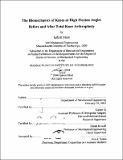The biomechanics of knees at high flexion angles before and after Total Knee Arthroplasty
Author(s)
Most, Ephrat, 1970-
DownloadFull printable version (16.72Mb)
Other Contributors
Massachusetts Institute of Technology. Dept. of Mechanical Engineering.
Advisor
Guoan Li and Derek Rowell.
Terms of use
Metadata
Show full item recordAbstract
Total Knee Arthroplasty (TKA) was initially developed to alleviate pain in the case of severe arthritis of the knee. Restoration of knee motion has been an on going issue for the last decade. Contemporary TKAs appear to provide good knee function in the range of zero to 120⁰ of flexion for most patients. However, many patients rarely can flex tier knees beyond 120⁰ after TKA. Limited information is available regarding the biomechanics of the knee beyond 120⁰ of flexion. Little is known about the biomechanical function of the posterior cruciate ligament in cruciate retaining TKA designs and the interaction of the cam-spine mechanism in posterior-stabilized TKA designs at flexion angles greater than 120⁰. The role of soft tissue constraint at high flexion angles has not yet been explored. The objective of this work was to investigate the biomechanics of the knee at high flexion angles before and after TKA. An in vitro experimental robotic set-up was used to measure six degrees-of-freedom kinematics and soft tissue kinetics of the intact knee. Contemporary TKA designs were then tested on the same specimen using this system to examine the limitations of currently available components to achieve high knee flexion. Both passive and muscle load kinematics were examined. Femoral translation and tibial rotation of the reconstructed knees were compared with that of the intact knees from full extension to 150⁰ of flexion. The study showed that in the intact knee, the amount of posterior femoral translation increased with increasing flexion angles on the passive path and under simulated muscle loads. Similar trend was noted for all TKAs. Yet, after any TKA, the knee exhibited a reduction in posterior femoral translation relative to the intact knee. The (cont.) posterior cruciate ligament in all knees carried lower load at high flexion as compared to the peak load it carried at mid knee flexion. The engagement of the femoral cam with the polyethylene spine in a posterior-stabilized TKA was correlated with an increasing posterior femoral translation. The function of the menisci was not simulated by any of the TKAs. In all knees, the compression of the posterior soft tissue at high knee flexion was correlated with an increase of posterior femoral translation. It is proposed that posterior femoral translation and internal tibial rotation ate high knee flexion are necessary but not sufficient features in achieving high knee flexion. Factors such as posterior soft tissue compression and contact mechanics should be considered.
Description
Thesis (Sc. D.)--Massachusetts Institute of Technology, Dept. of Mechanical Engineering, 2004. Includes bibliographical references (leaves 215-234).
Date issued
2004Department
Massachusetts Institute of Technology. Department of Mechanical EngineeringPublisher
Massachusetts Institute of Technology
Keywords
Mechanical Engineering.